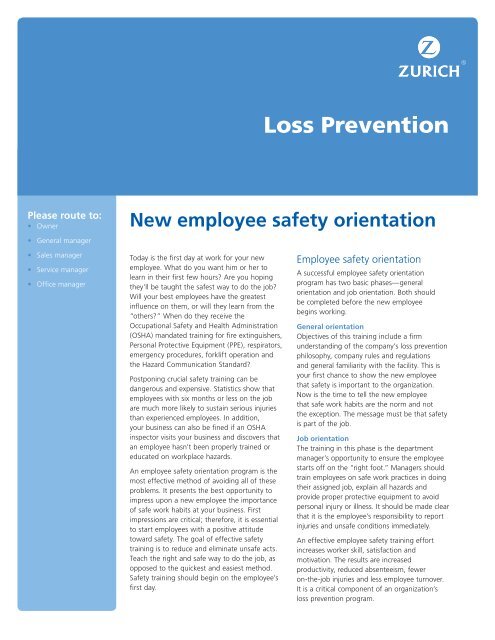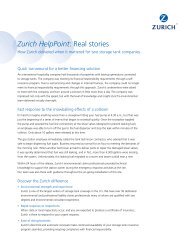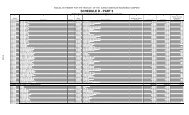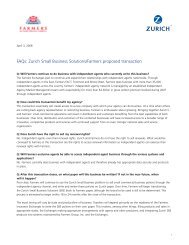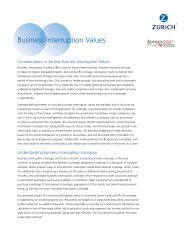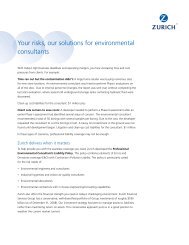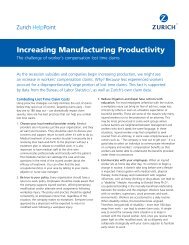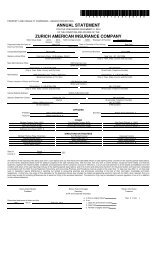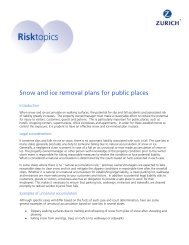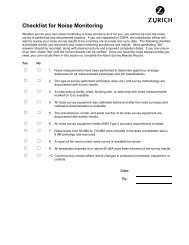New employee safety orientation
New employee safety orientation
New employee safety orientation
You also want an ePaper? Increase the reach of your titles
YUMPU automatically turns print PDFs into web optimized ePapers that Google loves.
Loss Prevention<br />
Please route to:<br />
• Owner<br />
• General manager<br />
<strong>New</strong> <strong>employee</strong> <strong>safety</strong> <strong>orientation</strong><br />
• Sales manager<br />
• Service manager<br />
• Office manager<br />
Today is the first day at work for your new<br />
<strong>employee</strong>. What do you want him or her to<br />
learn in their first few hours Are you hoping<br />
they’ll be taught the safest way to do the job<br />
Will your best <strong>employee</strong>s have the greatest<br />
influence on them, or will they learn from the<br />
“others” When do they receive the<br />
Occupational Safety and Health Administration<br />
(OSHA) mandated training for fire extinguishers,<br />
Personal Protective Equipment (PPE), respirators,<br />
emergency procedures, forklift operation and<br />
the Hazard Communication Standard<br />
Postponing crucial <strong>safety</strong> training can be<br />
dangerous and expensive. Statistics show that<br />
<strong>employee</strong>s with six months or less on the job<br />
are much more likely to sustain serious injuries<br />
than experienced <strong>employee</strong>s. In addition,<br />
your business can also be fined if an OSHA<br />
inspector visits your business and discovers that<br />
an <strong>employee</strong> hasn’t been properly trained or<br />
educated on workplace hazards.<br />
An <strong>employee</strong> <strong>safety</strong> <strong>orientation</strong> program is the<br />
most effective method of avoiding all of these<br />
problems. It presents the best opportunity to<br />
impress upon a new <strong>employee</strong> the importance<br />
of safe work habits at your business. First<br />
impressions are critical; therefore, it is essential<br />
to start <strong>employee</strong>s with a positive attitude<br />
toward <strong>safety</strong>. The goal of effective <strong>safety</strong><br />
training is to reduce and eliminate unsafe acts.<br />
Teach the right and safe way to do the job, as<br />
opposed to the quickest and easiest method.<br />
Safety training should begin on the <strong>employee</strong>’s<br />
first day.<br />
Employee <strong>safety</strong> <strong>orientation</strong><br />
A successful <strong>employee</strong> <strong>safety</strong> <strong>orientation</strong><br />
program has two basic phases—general<br />
<strong>orientation</strong> and job <strong>orientation</strong>. Both should<br />
be completed before the new <strong>employee</strong><br />
begins working.<br />
General <strong>orientation</strong><br />
Objectives of this training include a firm<br />
understanding of the company’s loss prevention<br />
philosophy, company rules and regulations<br />
and general familiarity with the facility. This is<br />
your first chance to show the new <strong>employee</strong><br />
that <strong>safety</strong> is important to the organization.<br />
Now is the time to tell the new <strong>employee</strong><br />
that safe work habits are the norm and not<br />
the exception. The message must be that <strong>safety</strong><br />
is part of the job.<br />
Job <strong>orientation</strong><br />
The training in this phase is the department<br />
manager’s opportunity to ensure the <strong>employee</strong><br />
starts off on the “right foot.” Managers should<br />
train <strong>employee</strong>s on safe work practices in doing<br />
their assigned job, explain all hazards and<br />
provide proper protective equipment to avoid<br />
personal injury or illness. It should be made clear<br />
that it is the <strong>employee</strong>’s responsibility to report<br />
injuries and unsafe conditions immediately.<br />
An effective <strong>employee</strong> <strong>safety</strong> training effort<br />
increases worker skill, satisfaction and<br />
motivation. The results are increased<br />
productivity, reduced absenteeism, fewer<br />
on-the-job injuries and less <strong>employee</strong> turnover.<br />
It is a critical component of an organization’s<br />
loss prevention program.
As an aid to ensure that all appropriate information has been presented to the <strong>employee</strong>, an<br />
<strong>employee</strong> <strong>orientation</strong> checklist should be used and signed by the <strong>employee</strong>. This checklist should be<br />
maintained in <strong>employee</strong> personnel files. Some suggested topics for the checklist include:<br />
l Discuss company loss prevention policy and<br />
<strong>safety</strong> regulations<br />
l Explain accident-reporting procedures<br />
l Location of first aid and eyewash stations<br />
l Explain emergency evacuation procedures and<br />
routes<br />
l Explain smoking regulations<br />
l Location of fire extinguishers and firefighting<br />
procedures<br />
l Review Hazard Communication program<br />
l Provide required personal protective equipment<br />
and train how to use (e.g. eyewear, respirators,<br />
hearing protection equipment)<br />
l Explain hazards associated with<br />
other departments<br />
l Discuss housekeeping requirements for<br />
assigned workplace<br />
l Explain facility inspection program to identify<br />
and correct hazards<br />
l Discuss the lockout - tagout program<br />
for equipment<br />
l Explain facility security procedures and systems<br />
l Eye protection should be worn when grinding,<br />
cutting or welding<br />
l Describe proper footwear and clothing<br />
l Explain “safe lifting” techniques and discuss<br />
weight limits<br />
l Demonstrate use of available material handling<br />
aids/devices<br />
l Explain electrical grounding protection of<br />
power tools and equipment<br />
l Explain proper use and storage of flammable<br />
liquids/materials<br />
l Discuss proper safeguards for welding<br />
and cutting<br />
l Discuss proper use of hand/power tools<br />
and equipment<br />
Loss prevention information<br />
For questions about this loss prevention topic, contact the<br />
Zurich Risk Engineering Department at 800-821-7803.<br />
Not a customer<br />
For more information about Zurich’s products and Risk<br />
Engineering services, visit www.zurichna.com/zdu or call us<br />
at 800-840-8842 ext. 7449.<br />
Already a customer<br />
Contact your Zurich Account Executive or agent for<br />
information about additional Zurich’s products and Risk<br />
Engineering services.<br />
11-3059 LC-086G (11/11) ©2011 Zurich American Insurance Company<br />
The information in this publication was compiled from sources believed to be reliable for informational purposes only. All sample policies and procedures herein should<br />
serve as a guideline, which you can use to create your own policies and procedures. We trust that you will customize these samples to reflect your own operations and<br />
believe that these samples may serve as a helpful platform for this endeavor. Any and all information contained herein is not intended to constitute legal advice and<br />
accordingly, you should consult with your own attorneys when developing programs and policies. We do not guarantee the accuracy of this information or any results<br />
and further assume no liability in connection with this publication and sample policies and procedures, including any information, methods or <strong>safety</strong> suggestions<br />
contained herein. Moreover, Zurich reminds you that this cannot be assumed to contain every acceptable <strong>safety</strong> and compliance procedure or that additional<br />
procedures might not be appropriate under the circumstances. The subject matter of this publication is not tied to any specific insurance product nor will adopting<br />
these policies and procedures ensure coverage under any insurance policy.


